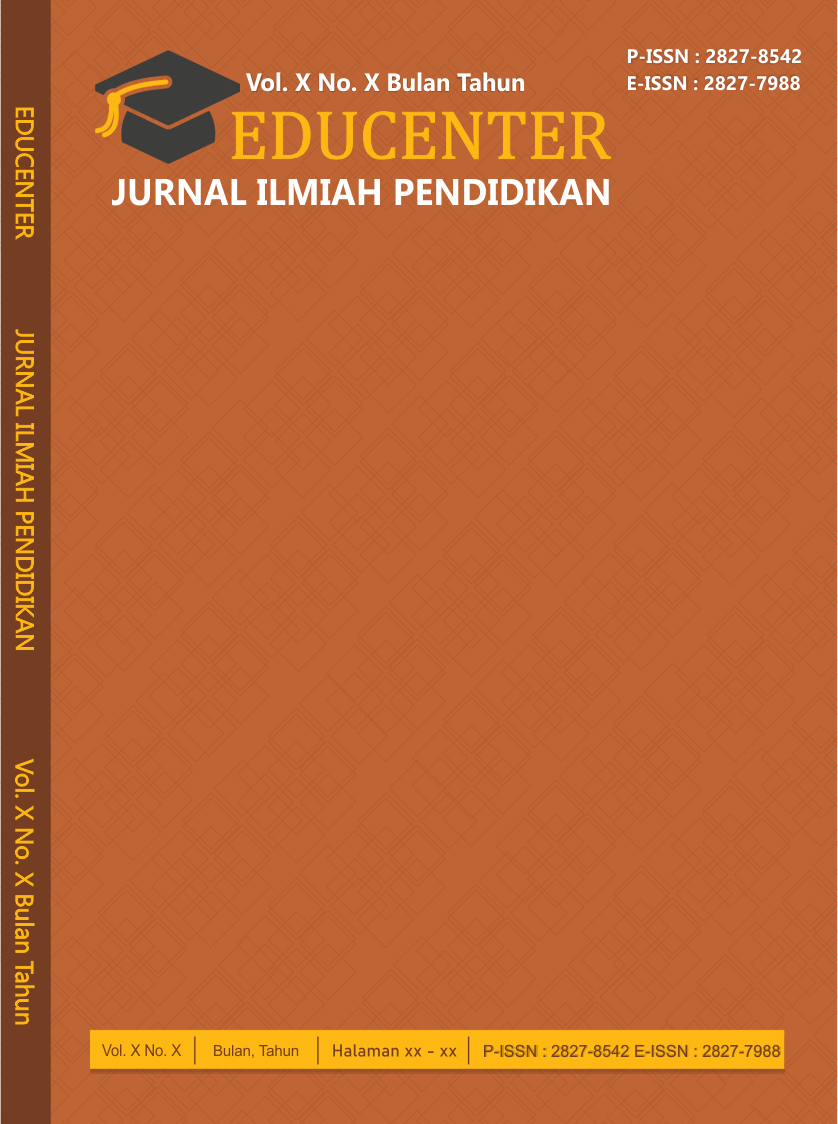The effect of problem-based learning model based on earthquake disaster mitigation on critical thinking ability
Main Article Content
Abstract
This study aims to evaluate the impact of Problem-Based Learning (PBL) on the critical thinking skills of eighth-grade students at MTs Alkhairaat Pusat Palu, with a particular focus on earthquake disaster mitigation. This research is important because Indonesia, as a disaster-prone country, requires an effective educational approach to prepare students to face emergency situations, especially earthquakes. PBL can provide relevant and contextual learning experiences. This study used a quasi-experimental approach with unequal control groups. Participants included two classes; class VIII C which was the experimental class and received PBL intervention, while class VIII D served as the control class and received conventional instruction. Data were collected through essay tests administered before and after the intervention. Normality and homogeneity tests were conducted on the data before conducting a paired-sample t-test. The findings showed that students' critical thinking skills in the experimental class improved significantly, reaching a post-test average while the control class was lower. The t-test results indicated that PBL had a significant positive impact on critical thinking skills. Therefore, the PBL model aimed at disaster mitigation has proven effective in improving the development of critical thinking skills in students.
Article Details
Section

This work is licensed under a Creative Commons Attribution-NonCommercial 4.0 International License.
How to Cite
References
Abdullah, I., & Ningrum, E. (2024). The influence of problem based learning models on students’ critical thinking ability on natural disaster mitigation material. Jurnal Ilmu Pendidikan (JIP) STKIP Kusuma Negara, 15(2), 159–169. https://doi.org/10.37640/jip.v15i2.1906
Amestiasih, T., Fadlilah, S., Rahil, N. H., & Pikardo, I. K. R. (2022). Upaya Meningkatkan Pengetahuan Menghadapi Gempa Bumi Melalui Program Edukasi. To Maega : Jurnal Pengabdian Masyarakat, 5(2), 263. https://doi.org/10.35914/tomaega.v5i2.1062
Ayub, S., Kosim, Gunada, I. W., & Taufik, M. (2021). Studi Mitigasi Bencana Gempabumi Berbasis Kearifan Lokal di Sekolah Dasar Pulau Lombok. KONSTAN: Jurnal Fisika Dan Pendidikan Fisika, 6(2), 88–95. http://jurnalkonstan.ac.id/index.php/jurnal/article/view/72
Azizah, M., Sulianto, J., & Cintang, N. (2018). Analisis keterampilan berpikir kritis siswa sekolah dasar pada pembelajaran matematika kurikulum 2013. Jurnal Pendidikan, 35(1), 61–70. https://doi.org/10.36312/10.36312/vol3iss5pp362-366
Ernanda, M., Suharsono, S., & Triyanto, S. A. (2022). The Effect of Implementing Problem-Based Learning in Lesson Study on Students’ Critical Thinking Skills. Bioedukasi: Jurnal Pendidikan Biologi, 15(2), 112–125. https://doi.org/10.20961/bioedukasi-uns.v15i2.61383
Fauzi, M., & Mussadun, M. (2021). Dampak Bencana Gempabumi dan Tsunami Pesisir Lere Kota Palu. Jurnal Pembangunan Wilayah Dan Kota, 17(1). https://ejournal.undip.ac.id/index.php/pwk/article/view/29967
Firdaus, A., Nisa, L. C., & Nadhifah, N. (2019). Kemampuan Berpikir Kritis Siswa pada Materi Barisan dan Deret Berdasarkan Gaya Berpikir. Kreano, Jurnal Matematika Kreatif-Inovatif, 10(1), 68–77. https://doi.org/10.15294/kreano.v10i1.17822
Fitria, N. A., Malik, Y., & Logayah, D. S. (2024). Hubungan Pembelajaran Mitigasi Bencana Dengan Sikap Kesiapsiagaan Bencana Gempa Bumi Dalam Pembelajaran IPSdi SMPNegeri 2 Lembang. Jurnal Ilmiah Wahana Pendidikan, 10(April), 734–740. http://www.jurnal.peneliti.net/index.php/JIWP/article/view/6791
Hitchcock, D. (2017). Critical thinking as an educational ideal. In On reasoning and argument: Essays in informal logic and on critical thinking (pp. 477–497). Springer. https://link.springer.com/chapter/10.1007/978-3-319-53562-3_30
Khoir, A., Rachmawati, T. A., & Usman, F. (2023). Kesesuaian Pola Ruang Kota Palu Terhadap Tingkat Risiko Bencana Gempa Bumi Dan Tsunami. Planning for Urban Region and Environment, 12(1), 175–186. https://purejournal.ub.ac.id/index.php/pure/article/view/493
Krishnan, P. (2024). A review of the non-equivalent control group post-test-only design. Nurse Researcher, 32(3). https://doi.org/10.7748/nr.2018.e1582
Maulidina, A., Effendi, A., & Sunaryo, D. Y. (2024). Model pembelajaran problem based learning (pbl) dalam meningkatkan kemampuan pemecahan masalah matematis siswa. Procceding Galuh Mathematic National Conference, 4(1), 3032–2588. https://jurnal.unigal.ac.id/GAMMA-NC/article/view/15246
Mulianingsih, F., Suharini, E., Handoyo, E., & Purnomo, A. (2025). Disaster Mitigation Tactics Through Enhanced Higher Order Thinking Skills via Active Learning in Social Science Education. Journal of Ecohumanism, 4(1), 3277–3283. https://doi.org/10.62754/joe.v4i1.6147
Muryani, C., & Ni’matussyahara, D. (2024). Strengthening student empathy in GeoCapabilities: Digital learning innovations and pedagogical strategies for disaster mitigation. Contemporary Educational Technology, 16(3), ep521. https://doi.org/10.30935/cedtech/14913
Prasetyo, F., & Kristin, F. (2020). Pengaruh Model Pembelajaran Problem Based Learning dan Model Pembelajaran Discovery Learning terhadap Kemampuan Berpikir Kritis Siswa Kelas 5 SD. DIDAKTIKA TAUHIDI: Jurnal Pendidikan Guru Sekolah Dasar, 7(1), 13. https://doi.org/10.30997/dt.v7i1.2645
Pu, D., Ni, J., Song, D., Zhang, W., Wang, Y., Wu, L., Wang, X., & Wang, Y. (2019). Influence of critical thinking disposition on the learning efficiency of problem-based learning in undergraduate medical students. BMC Medical Education, 19(1), 1. https://link.springer.com/article/10.1186/s12909-018-1418-5
Rachmadtullah, R. (2015). Kemampuan Berpikir Kritis Dan Konsep Diri Dengan Hasil Belajar Pendidikan Kewarganegaraan Siswa Kelas V Sekolah Dasar. Jurnal Pendidikan Dasar, 6(2), 287. https://doi.org/10.21009/jpd.062.10
Rokhimawan, M. A., Badawi, J. A., & Aisyah, S. (2022). Model-Model Pembelajaran Kurikulum 2013 pada Tingkat SD/MI. Edukatif : Jurnal Ilmu Pendidikan, 4(2), 2077–2086. https://doi.org/10.31004/edukatif.v4i2.2221
Saputra, A. R., Djayus, & Supriyanto. (2019). Pemetaan Daerah Rawan Kerusakan Akibat Gempa Bumi Di Wilayah Kota Palu Tahun 2000-2018 Berdasarkan Nilai Percepatan Tanah Maksimum. Jurnal Geosains Kutai Basin, 2(1979), 1–7. http://jurnal.fmipa.unmul.ac.id/index.php/geofis/article/view/466
Spiridonov, V., Ćurić, M., & Novkovski, N. (2025). Exploring Natural Hazards: From Earthquakes, Floods, and Beyond. In Atmospheric Perspectives: Unveiling Earth’s Environmental Challenges (pp. 271–306). Springer. https://link.springer.com/chapter/10.1007/978-3-031-86757-6_11
Subagia, I. W. (2015). Pelatihan Mitigasi Bencana Alam Gempa Bumi Pada Siswa Sekolah Dasar Negeri 1 Pengastulan Kecamatan Seririt Kabupaten Buleleng Bali. JPI (Jurnal Pendidikan Indonesia), 4(1), 585–598. https://doi.org/10.23887/jpi-undiksha.v4i1.4916
Suhirman, S., & Khotimah, H. (2020). The effects of problem-based learning on critical thinking skills and student science literacy. Lensa: Jurnal Kependidikan Fisika, 8(1), 31–38. https://doi.org/10.33394/j-lkf.v8i1.2794
Sukumaran, K. (2022). Impact of human activities inducing and triggering of natural disasters. In A System Engineering Approach to Disaster Resilience: Select Proceedings of VCDRR 2021 (pp. 17–31). Springer. https://link.springer.com/chapter/10.1007/978-981-16-7397-9_2
Widarti Gularsih Sukino, Muhammad Ahsan Samad, Nasir Mangngasing, & Abdul Rivai. (2019). Manajemen Mitigasi Bencana Kota Palu Palu City Disaster Mitigation Management. Journal of Public Administration and Government, 1(2), 1–8. https://doi.org/10.22487/jpag.v1i2.26

